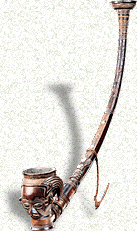
Pipe. Kuba. West Kasai, Zaïre. Bowl: wood, shells;
Stem: wood, metal, fibre.
© Africa-Museum, Tervuren

|
|

Comprising a series of subgroups
centralized under the authority of the Bushoong dynasty, the Kuba of Kasai
form a kingdom whose traditions, scrupulously memorized and passed on by
court historians, date back to the seventeenth century.
The Kuba's finely crafted creations are associated with the king or
important dignitaries, or with initiation rituals. Among the most famous are
the ndop statues: idealized portraits, produced between 1760 and the end of
the nineteenth century, of various sovereigns. Their function remains
unclear: are these commemorative figures produced following the death of a
king or are they receptacles produced during his lifetime in which to
collect the divine spirit and transmit it to his successor?
Kuba masks, representing nature spirits, are considered sacred and are worn
during funerals and initiation rituals. Some belong exclusively to the king
and are worn in acting out myths about the foundation of the Kuba kingdom.
Kuba artists have produced a great diversity of objects: everyday items as
well as items of prestige. The variety and wealth of decoration on these
cups, pipes, enemas, friction oracles, etc., draw on a complex symbolism.
In the south-west of the Kuba kingdom, the Lele occupy the region between
the Loange and Kasai rivers. Although not a part of the cultural complex of
the Kuba, the Lele have been significantly influenced by Kuba art.
The Ndengese, situated to the north-west of the Kuba, have also come under
their influence. The Ndengese are best known for a unique type of statuary:
chiefs or dignitaries are sculpted with their lower limbs shortened in order
to accentuate the trunk of the body, which is covered in symbolic engravings.
|
![]()
![]()
![]()
![]()